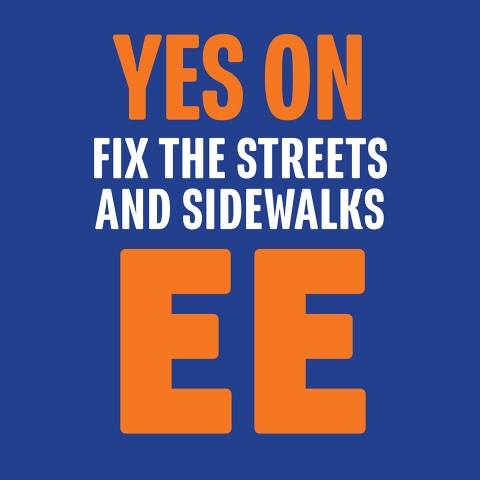
Is Measure FF better for the climate than Measure EE? It’s doubtful.
If you are tired of Berkeley’s potholed streets and broken sidewalks, you should vote Yes on Measure EE. It will repair our roads and walkways, invest in bicycle boulevards, and make our city safer for pedestrians and cyclists, supporting car-free travel. There is a competing measure on the ballot that will also pave streets and fix sidewalks but will cost much more and lock in changes to Berkeley streets that can create serious problems for seniors, disabled people, small businesses, first responders, and everyone in the city who needs to evacuate in an emergency. If you don’t want your neighborhood to be turned upside down without your consent, vote No on Measure FF.
The problem is that the fine print of Measure FF prioritizes funding the construction of miles of curb-separated two-way cycle tracks on most of Berkeley’s major streets. Proponents argue this will be safer but, on many of the proposed streets, the construction of these tracks violates the safety recommendations of the very experts who invented them regarding where such infrastructure is suitable. Narrow streets and streets that have many driveways (such as Hopkins Street) or many cross streets (such as Fulton Street) are strongly contra-indicated. The failure to account for the needs of emergency vehicles and evacuations in their designs, called out publicly by Berkeley’s fire chief, helped scuttle proponents’ first attempt to force through a cycle track on Hopkins. A major concern is that in our hilly city, cycle tracks will be dominated by fast, heavy e-bikes, which can make negotiating these tracks dangerous for the seniors, blind people, and people in wheelchairs who must cross them, and for children and inexperienced cyclists who attempt to use them. Not surprisingly, Berkeley advocates for the aging and disabled have expressed serious reservations about the cycle track plan.
I am an energy planner who has worked on decarbonization and climate protection for years. I appreciate living in Berkeley where people take climate change seriously. If you read Measure FF, you will see that it appeals to Berkeley voters by referencing the climate emergency. But I have found no serious study showing that Measure FF would reduce greenhouse gas emissions any more than the much less costly and disruptive Measure EE. Since neither the proponents nor the city have provided credible analysis or data by which the emissions benefits of the plan can be objectively evaluated, I just offer three observations.
First, in the near term, if more cycle tracks are built, it could dramatically reduce parking for small businesses in many parts of Berkeley. Putting aside the unstudied but potentially disastrous effect on the businesses – many of them minority owned – that give our neighborhoods their character, will removing parking really lead to fewer car-miles being driven for shopping? My guess is that most people who drive to shop (the aged, the mobility challenged, people who live in the hills, etc.) will continue to do so. If so, the result could be an increase in driving as Berkeley exports its shoppers to surrounding cities with available parking, with longer average round trips. Even with more bicycle riding, this could still result in higher net emissions. In addition, removing turn and bypass lanes at intersections to make room for cycle tracks is likely to cause traffic jams, idling, and emission increases.
Second, in a decade or so in California, and probably earlier in Berkeley, almost all new cars will be electric, and the electricity to charge them will be virtually carbon free. This is state policy, supported by federal tax credits, technology developments, and market forces. The carbon emissions of a shopping trip by car will approach that of one by bicycle. It is true that the emissions embedded in building a car are greater than for bicycles and reducing car ownership would reduce those emissions. But will Measure FF actually lead to people not owning cars? It’s hard to make that case. People who bike and walk also own cars. Federal statistics show that walking, biking, and transit ridership shares have remained flat for decades. That’s a big reason state and federal policies focus on vehicle electrification rather than assuming dramatic changes in how people travel.
Third, bicycling and walking are great, and its vital for Berkeley to make these safer. That’s what Measure EE will do. Perhaps this will move the needle on reducing car travel. But portraying cars versus bicycles as a moral issue when the emissions benefits of a plan like Measure FF are highly uncertain is a strategic mistake for climate advocates. Demonizing drivers and riding roughshod over neighborhood concerns will not hasten the industrial-scale energy transition that climate protection requires. Advocates should pump the brakes on performative environmentalism that is more likely to create a political backlash.
Jim Williams is a professor of Energy System Management at the University of San Francisco and long-time Berkeley resident. His modeling of decarbonization pathways underlies many state, federal, and international climate policies.

